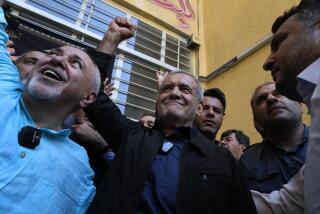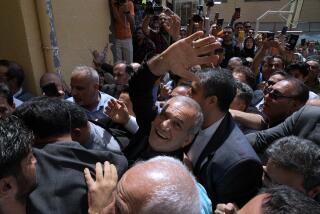Time Is Running Out for Tehran Regime
- Share via
The Iranian people are battling in the streets of Tehran for the right to chart the future of the Islamic Republic. Rather than an ideological death struggle between aspiring moderates and Islamic militants for control of the culture and the political system, the attacks by the army and vigilantes last week on students demonstrating for reforms represent the last ditch efforts of the regime’s hard-liners to protect personal interests bestowed by the revolution.
Outside its nationalist component, the Iranian revolution of 1979 was a social revolution that unfolded in two parts. In toppling the shah in the first phase in 1979, the middle and lower classes sheared the top off a hierarchical social structure that, in spite of frequent mutations, had dominated Iranian life for centuries. This was the broad-based revolution that the middle class and the intelligentsia believed would bring democratic, secular government to Iran.
Then in the revolution’s second phase in 1981, the Islamic Republic took what was left of the pre-revolutionary social pyramid and turned that upside down. In the new order presided over by Ayatollah Ruhollah Khomeini, people from the villages and the urban lower classes rose to the top of the social and political order by virtue of their commitment to Islamic revolutionary ideology.
Much the same thing happened with the hierarchical structure of the clergy. Traditionally, a cleric’s position within the upper echelons of Shia Islam has resulted from social class and theological credentials. In the late 1970s, differing theological interpretations kept some clerics of the upper class out of Khomeini’s Islamic revolution. Other clerics from the high end of the social spectrum, such as former president Hashemi Rafsanjani, not only supported the revolution but served in the highest ranks of Islamic government.
Yet, after Khomeini’s death in 1989, Rafsanjani and many clerics from the upper social classes who were part of the regime began to direct government away from its all-consuming commitment to Islam and the social revolution and toward Iranian national interests. This redirection proved difficult. Most of the positions in government were now occupied by clerics and their allies who came out of the lower echelons of pre-revolutionary society. In the shrines and religious schools, highly coveted positions were held by those possessing more political connections than theological or social credentials. Together, these clerical sons of the revolution had become the political and economic elite of the Islamic Republic. And they remain so today.
At the top of this system of political/clerical power sits the spiritual leader, who is the final arbiter of government decisions. It is a system devised by Khomeini, which worked relatively well until his death. Khomeini commanded such authority derived from his piety and charisma that he could play the role of arbiter between competing factions. But the current spiritual leader, Ali Khamenei, is more a political hack than a revered theologian. He has maintained his exalted rank only by protecting the interests of his supporters by enforcing social restrictions and political control through the use of politicized Islam.
What is probably a minority of the Iranian population has been able to exercise disproportionate power. Both the 1979 revolution and the 1981 constitution took Iran from a system in which all power resided in the shah to one in which power is so dispersed that government can operate only through consensus. Outside the presidency and the cabinet, the levers of power are in the hands of the conservative defenders of the Islamic Republic. Wielding the constitutional authority to vet candidates for public office, their hold on power has become self-perpetuating.
The promised reforms that elected Mohammad Khatami and fueled this month’s student demonstrations pose a dire threat to the political and personal fortunes of the hard-line clerics. The mobs the clerics have called into the streets in support of the status quo share the mullahs’ fear that change will strip from them gains won in the revolution and solidified during the Iran-Iraq War.
The hard-liners and their supporters are playing a losing game. The 70% majority that Khatami garnered in the 1997 presidential election and the moderates’ victory in the March municipal elections represent an inescapable demand for cultural liberalization and increasing democracy. In this sense, the depiction of Iran as a battlefield between radicals and moderates is true. But Iran’s current turmoil goes deeper than that. The Iranians have spent much of the 20th century searching for just government. Today, only a minority sees justice as well as social and economic protection in Islamic government in its present form. The majority sees justice with a civil society governed by the rule of law and cultural freedoms. It is this majority that will either reform or dismantle the Islamic Republic.
More to Read
Sign up for Essential California
The most important California stories and recommendations in your inbox every morning.
You may occasionally receive promotional content from the Los Angeles Times.










